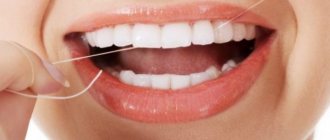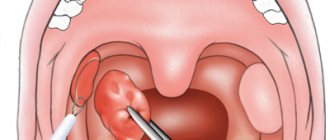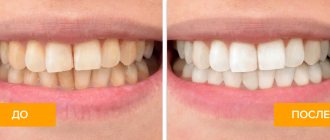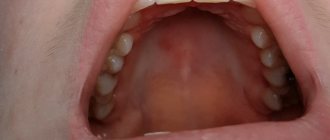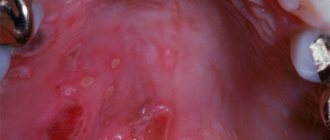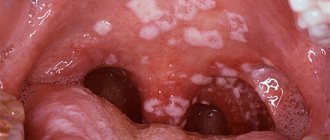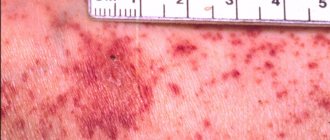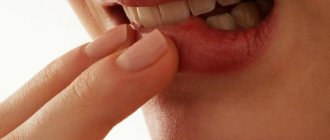Author of the article:
Soldatova Lyudmila Nikolaevna
Candidate of Medical Sciences, Professor of the Department of Clinical Dentistry of the St. Petersburg Medical and Social Institute, Chief Physician of the Alfa-Dent Dental Clinic, St. Petersburg
The human oral cavity has its own microflora and its own specific diseases arise. Let's talk about one of them - fibrous epulis of the gums: what kind of disease it is, what are the causes of its occurrence, how is the treatment carried out.
Bumps in the mouth: what they are, their causes and treatment
Any neoplasms in the oral cavity require careful study of the clinical picture. This can be either a harmless growth or an alarming signal from the body. Thus, a lump on the roof of the mouth often occurs as a result of a cold or infection. This formation does not cause discomfort and resolves on its own after strengthening the immune system. If the growth is accompanied by pain and other unpleasant symptoms, this may indicate a serious pathology. Only a doctor can determine the cause of the lump and tell you what to do.
Characteristics of a blood bubble on the oral mucosa
The mucous membrane protects the entire body from the negative influence of the environment, from harmful microorganisms, various types of pollution, and also has a fairly high level of regeneration. If blood blisters regularly appear on the oral mucosa, then you should take this signal seriously and take action.
A bloody ball in the mouth is a hematoma (bruise), which is characterized by the accumulation of blood in a certain place in the oral cavity. The appearance of bloody blisters is a kind of hemorrhage that occurs due to trauma to the capillaries and thin vessels of the mucous membrane.
A blister on the mucous membrane may contain clear serous fluid without the presence of blood. This means that the vessels were not damaged and the resulting wound is superficial. Such blisters on the mucous membrane heal much faster. The presence of blood in the bladder indicates a deep injury and a longer period of healing and blood resorption.
Why do bumps appear in the sky?
A growth in the mouth appears as a result of blockage of blood vessels and stagnation of organic fluids, which causes inflammation in the mucosal tissues. Among the most common causes of pathology are the following:
- bad habits – alcohol abuse and smoking;
- chronic diseases – sore throat, sinusitis;
- constant exposure to traumatic factors - incorrectly fitted crowns that become infected, eating too hot food, sucking on lollipops, etc.;
- insufficient oral hygiene - food remains behind the teeth become a favorable environment for the development of pathogenic microflora;
- inflammation of the salivary glands;
- colds and infectious diseases;
- Doctor’s mistakes – incorrect filling or tooth extraction.
A child can also develop a lump in the mouth. In most cases, the pathology occurs due to bruises, which are quite common in childhood.
Bumps also form in the mouth due to cancer (leukoplakia and papillomatosis), which pose a great danger to human health and life.
The mechanism of formation of a blood bubble on the oral mucosa
Bloody blisters in the mouth in most cases are not life-threatening. They are formed as a result of mechanical damage to the mucous membrane. When microtrauma occurs, harmful microorganisms attack the damaged area.
After this, a number of responses are activated in the human body:
- The immune system is activated. Monocytes and leukocytes, as well as macrophages, instantly arrive at the damaged area, attacking the harmful pathogen and quickly destroying it.
- Immune cells die. This is a signal for other cells and substances are released in the affected area that are mediators of inflammation of the mucous membrane - serotonin, histamine and bradykinin.
- These substances cause a strong spasm of the circulatory system and the outflow of blood is hampered. After the spasm is relieved, all accumulated blood immediately flows to the site of inflammation. It moves at high speed and under pressure. A detachment of the mucous membrane occurs in the mouth, and a bloody blister appears.
General symptoms
A tumor formed in the oral cavity can be of different colors: white, dark red, blue, transparent yellow. Sometimes it is soft, in other cases it is dense. A lump that appears against the background of one pathology may differ depending on the individual characteristics of the patient’s body: age, general condition of his body, bad habits, etc.
The lump appears in the form of a bubble, growth, ball, compaction, tumor with faint edges. Spots (change in color of the mucous membrane) may also form in the affected area. In some cases, numbness is felt in a certain part of the oral cavity, difficulties appear when swallowing, and the voice changes. In advanced forms of the disease, the cones may be damaged, which provokes bleeding with an unpleasant taste and odor.
Painful lumps indicate inflammation and suppuration. General health worsens, body temperature may rise. Purulent intoxication of the body occurs. In this case, the lump grows, it becomes hard and hot, and the regional lymph nodes enlarge.
Diagnosis of diseases accompanied by the formation of lumps in the mouth
Tumors have appeared in the mouth, and the question is, which doctor should I contact? This symptom is a prerequisite for visiting the dentist. To diagnose the disease, the doctor will first conduct a visual examination and palpation, and collect an anamnesis. A puncture is taken from the resulting lump and a bacteriological examination is carried out, which makes it possible to determine the cause of its occurrence.
Based on the results obtained, the doctor determines the need to use other diagnostic methods:
- general tests;
- X-ray;
- Ultrasound;
- biopsy.
If the cause of the formation of a lump on the upper palate is beyond the scope of the dentist’s competence, the patient is prescribed consultations with other specialists (pediatrician, therapist, gastroenterologist, endocrinologist, hepatologist). Only after making a diagnosis will the doctor determine how to treat the disease.
Symptoms of hematomas in the oral cavity
The most noticeable sign is the spread of vesicles with bloody contents throughout the mucosa. Often there are no other symptoms of pathology. Sometimes patients complain of itching and tingling in the area of damaged tissue. Doctors say that this is a reaction to additional chemical and mechanical irritation of the inflamed mucous membrane under the influence of saliva, contact with teeth, etc. When hematomas form on the oral mucosa during tooth eruption, there are sensations of bursting and pressure from within the gum tissue. If inflammation has become a complication of a burn, pain is a logical consequence of mechanical irritation of the mucous membrane.
Signs of the appearance of blood balls on the cheeks in the mouth, requiring immediate examination and diagnosis, are included in a separate group. Among them:
- relatively frequent appearance of a large number of points of inflammation;
- the duration of wound healing, despite the measures taken to treat them;
- hematomas that are too large, interfering with eating and full communication;
- formation of bloody balls on the lips.
Each of these signs can be a symptom of serious disorders in the body. Therefore, the optimal solution would be to refuse self-medication and schedule a consultation with a qualified dentist.
Dental diseases
At an advanced stage of periodontitis, a fistula forms near the tooth involved in the painful process. If periostitis (inflammation of the periosteum) develops, flux may appear. At first the lump is hard, but over time it becomes softer and filled with pus.
In case of periodontitis, the tooth is unfilled and the root canals are cleaned. After removing the exudate, oral baths are prescribed using special solutions. In case of periostitis, the dentist opens the tooth, places medications in the cavity, and closes it with a temporary filling. If this treatment does not help, the tooth is removed.
Angioma
It is a benign formation, which in most cases is a congenital pathology in children. It consists of blood vessels and is dark red in color. Sometimes it looks like a small ball on a leg. Lymphangioma, formed from lymphatic vessels, most often appears on the soft palate. It looks like a small bump with a bubbly surface. First, the tumor grows inside, then a swelling appears that hurts.
The choice of treatment method depends on the type of vessels. The angioma is removed or reduced by sclerotherapy, alcohol injection, or radiation therapy. If there is a risk of severe swelling, the formation is excised with a scalpel. The ball-shaped angioma is removed using a galvanoacoustic loop.
SexCorrect bite: How to choose the right gag
TEXT: Tatyana Nikonova, author of the sex blog Nikonova.online
Gags have long been widely used in sexual games, but while some people lovingly gag their partners, others only dream about it - the inability to talk excites and allows you to focus on pleasure. However, choosing the right one for you or your partner is not an obvious thing. We'll tell you what rules you need to follow to shut your mouth to everyone's satisfaction.
The first thing to remember: do not use gags if you or your partner have cardiovascular or pulmonary disease, asthma, epilepsy or claustrophobia. The list of contraindications also includes any type of acute respiratory infection and jaw dislocation in the past. If all this doesn’t apply to you, feel free to go to a well-known sex shop or a trusted network: remember that everything you put into yourself should be made of high-quality materials, and in a small store selling no-name you can get different things.
A gag is an item for individual use, like a toothbrush. If you can exchange saliva with a regular partner as much as you like, then in other cases a separate item is bought, and not pulled out of the bins, they say, I have this thing here that was stuck in a variety of people. Don’t do this, and don’t be tempted by stories about disinfection.
Determine the purpose of using the gag. If it is necessary to prevent a person from saying a word, the bulk of the gag is located inside the mouth and secures the lower jaw and tongue. For beginners, this option is unlikely to be pleasant - it is usually used in BDSM games, where physical and psychological discomfort are important. But sexual moaning from a partially closed mouth is very exciting and is unlikely to lead to injury. It’s best to start with a snaffle - a stick covered with soft material that doesn’t force you to keep your mouth wide open: you won’t get tired with it and you definitely won’t confuse indignant sounds with satisfied ones.
There are several important requirements for a ball gag. First, look for one that is hollow and has holes so you don't have to worry about air leaks. Secondly, choose the right size. Open your mouth as if you were about to bite into a large hamburger, hold it for about twenty seconds, then measure the distance between your teeth - this will be the maximum diameter of the ball of your gag. In fact, you should take one finger less, otherwise your jaw will immediately go numb. Thirdly, the material of the gag must be soft and elastic, because you will have to dig into the ball with your teeth. Take care of your teeth, you will need them later.
Another type of gag is a ring or spacers. The mouth is not closed with them, but it will not be possible to talk because it does not close. Use on a person who trusts you, since such items always evoke an acute feeling of defenselessness, and this only brings pleasure if there is real intimacy. But rings and spacers provide access to oral sex. Men can use any comfortable variety, women can use a ring because it’s easy to spit out if things get uncomfortable.
A gagged person should be prepared to drool, as should his partner. Even so: TO THE DROEL. Most gags do not allow you to swallow normally, so a lot of saliva accumulates. Hence the requirement for air access to the mouth - it will flow in the opposite direction. Also, never put a gagged person on his back - he may suffocate from an excess of drool, or it will cause him to vomit (and the gag has not yet been removed!). In general, drooling is good and means that everything is more or less in order.
A gag involves tied hands, but it is better to keep both of them conditionally fixed. The safest gag is on a wide soft tape (for example, neoprene) with Velcro fastener. You can remove it yourself if something goes wrong. Hands can also be tied, but loosely for ease of untangling. You are playing, right? Therefore, the rules can be followed formally. In difficult situations, it is suggested to agree on a safe word in advance, but you can’t chat much with your mouth shut, so agree on the movements, or, for example, you can pick up a bell. Any sound of it is a sign to completely stop actions.
But it is not necessary to buy a gag; you can always use improvised means. But so that arbitrariness does not end tragically, remember the main rules. The gag should be soft. A ribbon, tie or even a T-shirt - no hard objects to avoid getting hurt. You can injure the edges of your mouth or mucous membranes, and even break your teeth. This is not entertainment, but self-harm.
Another important rule for homemade gags is that everything should be more or less clean and not contain anything dangerous in or on itself. For example, a T-shirt that was used to paint a wall will leave traces of paint on it, and they are not for ingestion - neither for ingestion nor for inhalation over time. Therefore, even if passion suddenly dismantles you, move to a more suitable place and find safe objects.
A homemade gag should consist strictly of one item, only then will you be able to keep everything under control - regardless of whether you are wearing it or you are putting it on. Specifically, this means that you either gag or put something inside but don't put it together. The film "Candy" with Rose McGowan begins with gagging errors and leads to tragedy: a girl is stuffed with a ping-pong ball in her mouth and gagged, the heroine suffocates and dies.
In general, tying is better than tucking, and a narrow bandage that leaves access for breathing through the mouth is preferable to a wide bandage covering half the face. Firstly, it is difficult to suffocate. Secondly, it is not difficult to spit out a neat and not very wide bandage. Thirdly, a narrow headband is a soft version of a bit, and if necessary, you can even say something.
What you definitely shouldn't do is use tape instead of a gag. The glue causes skin irritation, peeling off the tape is as painful as doing waxing, and the wide tape does not allow you to breathe through your mouth or speak. A little runny nose - and hello. The only option is a special vinyl tape that sticks only to itself, but not to the skin. It looks like tape, but you have to wrap it around your head instead of the movie silver stripe from cheek to cheek.
If you still want to put something in your mouth, then choose something with a volume of no more than half a woman’s fist. That is, thong panties will do, but family size 56 panties should mostly hang outward from the mouth.
Well, the simplest, but also the most important rule that sums up all of the above: do not do anything to a loved one that you would not want done to you, and always first obtain his consent. You yourself will be healthier, and the chances that your partner will like it and want to repeat it are rapidly growing.
Photos: Liaurinko - stock.adobe.com, Amorelie, Erofly, El Pirulo Volador, Desire Sex Shop
Preventive measures
To reduce the risk of developing pathologies in the oral cavity, you should follow a number of recommendations:
- quit smoking and alcohol;
- normalize nutrition - do not eat hot, salty and spicy foods, introduce fermented milk and plant products into the diet;
- carefully and regularly observe oral hygiene;
- start treatment of any pathologies in a timely manner;
- Take vitamin complexes periodically (after consultation with your doctor).
If you experience the slightest discomfort in the palate, you should see a dentist. Paying attention to your health prevents the development of complications.
